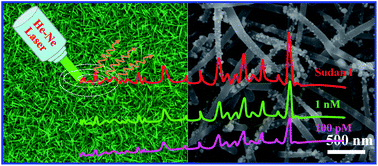Surface-enhanced Raman scattering (SERS) sensing has always been considered as a kind of high-efficiency analysis technique in different areas. Herein, we report a AgNPs decorated 3D bionic silicon (Si) nanograss SERS substrate with higher sensitivity and specificity by green galvanic displacement. The Si nanograss arrays are directly grown on a Si substrate via catalyst-assisted vapor–liquid–solid (VLS) growth and subsequent plasma interaction. AgNPs were rapidly immobilized on Si nanograss arrays without any organic reagents, and avoiding the interference signal of additives. The AgNPs decorated 3D bionic silicon nanograss arrays not only possess a larger specific surface area (loading more reporter molecules), but also provide a potential distribution and arrangement for plentiful hot spots. Using Rhodamine 6G (R6G) as a probe molecule, the prepared SERS substrates exhibited great potential for high-sensitivity SERS sensing, and pushed the limit of detection (LOD) down to 0.1 pM. A higher Raman analytical enhancement factor (AEF, 3.3 × 107) was obtained, which was two magnitudes higher than our previous Ag micro–nano structures. Additionally, the practicality and reliability of our 3D bionic SERS substrates were confirmed by quantitative analysis of the spiked Sudan I in environmental water, with a wide linear range (from 10−10 M to 10−6 M) and low detection limit (0.1 nM).

